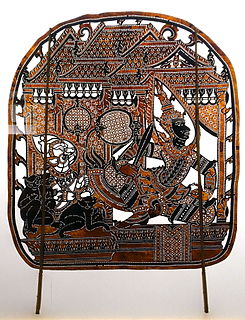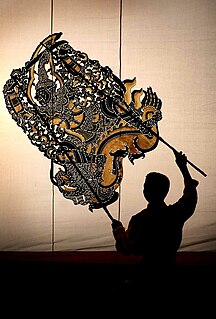 W
WShadow play, also known as shadow puppetry, is an ancient form of storytelling and entertainment which uses flat articulated cut-out figures which are held between a source of light and a translucent screen or scrim. The cut-out shapes of the puppets sometimes include translucent color or other types of detailing. Various effects can be achieved by moving both the puppets and the light source. A talented puppeteer can make the figures appear to walk, dance, fight, nod and laugh.
 W
WKaragiozis or Karaghiozis is a shadow puppet and fictional character of Greek folklore, is an offspring of the Turkish shadow play Karagöz and Hacivat. He is the main character of the tales narrated in the Turkish and Greek shadow-puppet theatre.
 W
WKaragöz and Hacivat are the lead characters of the traditional Turkish shadow play, popularized during the Ottoman period and then spread to most nation states of the Ottoman Empire. It is most prominent in Turkey, Greece, Bosnia and Herzegovina and Adjara. In Greece, Karagöz is known by his local name Karagiozis; in Bosnia and Herzegovina, he is known by his local name Karađoz.
 W
WKhmer shadow theatre are forms of shadow play in which leather shadow puppets are used. The two main genres are Sbek Thom, which features the Reamker, and Sbek Toch, which uses smaller puppets and a wide range of stories. Another genre called Sbek Por uses colored leather puppets. The shadow plays of Cambodia are closely related to and also resemble the shadow plays of Thailand, the Malay Peninsula and Indonesia (Wayang kulit).In Cambodia, the shadow play is called Nang Sbek Thom, or simply as Sbek Thom, Sbek Touch and Sbek Por.
 W
WNang talung is a traditional style of shadow puppetry from southern Thailand. Similar arts are found in Cambodia, Malaysia, and Indonesia. Nang means "leather", and talung is an abbreviation of Pattalung, a southern city where the shadow play tradition has long been popular. Nang yai features life-size puppets, while nang talung puppets are much smaller.
 W
WNang yai is a form of shadow play found in Thailand. Puppets are made of painted buffalo hide, while the story is narrated by songs, chants and music.
 W
WRabana Chhaya is a form of shadow puppetry from the eastern Indian state of Odisha.
 W
WEvgenios Spatharis was the most prominent shadow theatre artist in Greece. He is credited with having brought the traditional Karagiozis plays to mass audiences through television, recordings and cinema.
 W
WTholpavakoothu தோல்பாவைக்கூத்து is a form of shadow puppetry that is practiced in Kerala,Tamil Nadu, India. It is performed using leather puppets and is performed in temples or in villages in specially built theatres. This form of art is especially popular in the Maduraiand nearby districts of Madurai in TamilNadu and also in palakkadThrissur and Malappuram districts of Kerala.
 W
WTholu bommalata is the shadow puppet theatre tradition of the state of Andhra Pradesh in India. Its performers are part of a group of wandering entertainers and peddlers who pass through villages during the course of a year and offer to sing ballads, tell fortunes, sell amulets, perform acrobatics, charm snakes, weave fishnets, tattoo local people and mend pots. This ancient custom, which for centuries before radio, film, and television provided knowledge of Hindu epics and local folk tales, not to mention news, spread to the most remote corners of the Indian subcontinent. Tholu bommalata literally means "the dance of leather puppets".
 W
WTogalu gombeyaata is a puppet show unique to the state of Karnataka, India. Togalu gombeyaata translates to "a play of leather dolls" in the native language of Kannada. It is a form of shadow puppetry. Karnataka Chitrakala Parishat has undertaken research on this art and has a good collection of leather puppets.
 W
WWayang kulit is a traditional form of puppet-shadow play originally found in the cultures of Java, Bali, and Lombok in Indonesia. In a wayang kulit performance, the puppet figures are rear-projected on a taut linen screen with a coconut-oil light. The dalang manipulates carved leather figures between the lamp and the screen to bring the shadows to life. The narratives of wayang kulit often have to do with the major theme of good vs. evil.